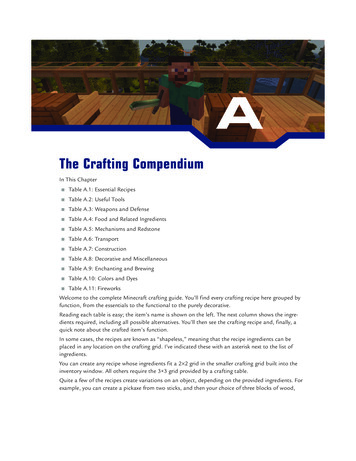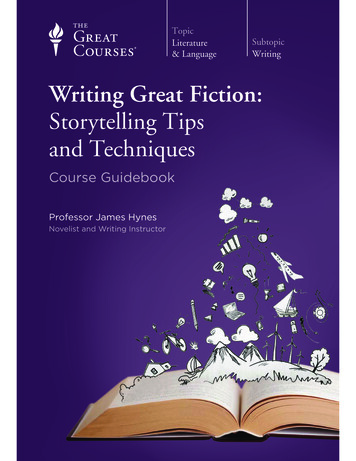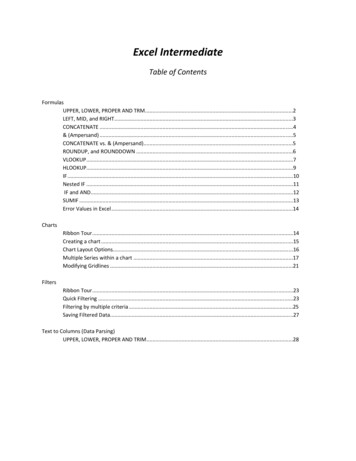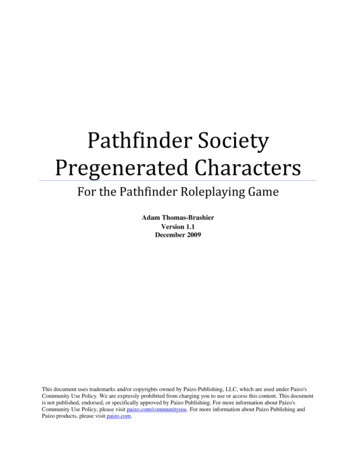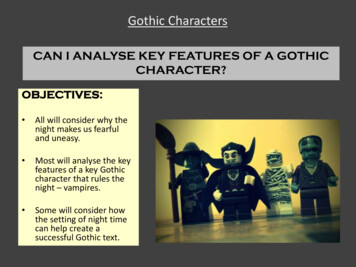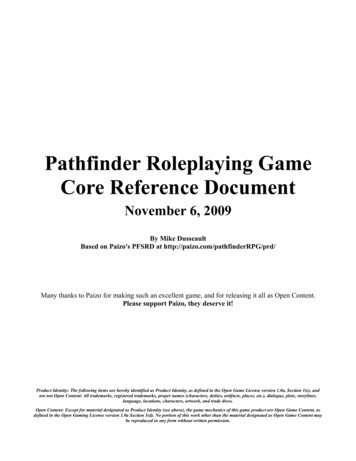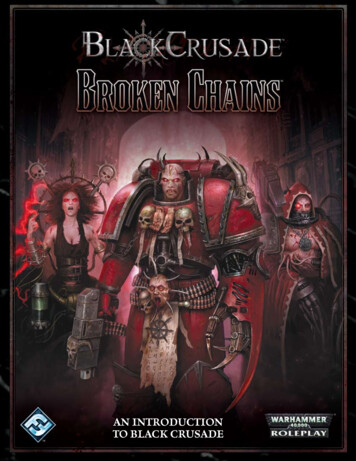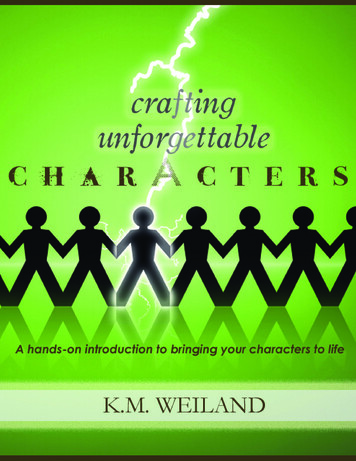
Transcription
1
Table of ContentsIntroduction: Characters, the Most Important Facet of Your Story.3Interviewing Your Characters.5Utilizing Character in Beginnings.12It’s What Your Characters Do That Defines Them.17Naming Characters.20Describing Characters.26Choosing Your Character’s Career With Care.30What Dickens Can Teach Us About Complex Characters.33The All-Important Link Between Theme and Character.38Likability Is Overrated.4311 Dichotomous Characters—And Why They Work.462
Introduction:Characters, the Most ImportantFacet of Your StoryA story is a composite of a thousand differentpieces: plot, theme, action, dialogue, point ofview, backstory, conflict, humor, pacing,setting, subtext—ad infinitum. Take one ofthese parts away, and the whole falls apart.But no one element is so vital as that ofcharacter. No matter how we dress them up infancy new subgenres, no matter how manyshocking plot twists we throw into theendings, no matter how complex andphilosophical our themes, at the end of theday, stories will always be about people. Thetrick, of course, is making sure our storiesfeature people worth reading about.Plot versus character is a hotly contesteddebate. Readers want thrilling, mind-tinglingplots. They want to be wowed by theintricacies and the suspense. As a result, wecan sometimes lose sight of the fact that plotis nothing without character. No character, noplot. You can conceive a gripping, brilliantplot, but unless you have the characters toback it up, most people could care less.In a February 2006 Writer’s Digest article, legalsuspense author James Scott Bell asserts thatwhat makes characters unforgettable is thepossession of “at least one of the followingcharacteristics—grit, wit, and ‘it.’” We lovecharacters who are courageous, characterswho are smart or funny, characters who havethat special “star power,” or what Bell3“The moment comeswhen a characterdoes or sayssomething youhadn’t thoughtabout. At thatmoment he’s aliveand you leave itto him.”—Graham Greene
described as “personal magnetism.” But wealso want characters that smack of realism.We want to read about people who are real,people who make us understand somethingabout life that we may have missed and affirmthings we already appreciate.So how do we go about creating thesememorable personalities? In the followingpages, you’ll discover the basics of characterbuilding, as well as some tips fortroubleshooting. You’ll also discover writingprompts, creativity exercises, and inspiringquotes from successful authors.The discussion of character is far too vast asubject to be covered in a 50-page e-book, butusing the information herein, you’ll have thetools you need to start making your latestbatch of characters unforgettable.4
Interviewing YourCharactersHow well do you know your characters? Likethe back of my hand, you say? Do you knowthe color of your hero’s eyes? Do you knowwhere the bad guy went to college? Do youknow your heroine’s most embarrassingmoment? Can you rattle off a list of yourmain character’s idiosyncrasies? Typicalexpressions? Romantic history?If any one of these questions has youfumbling for an answer, you’re missing aprime opportunity to deepen your charactersand expand your story. Over the years, one ofthe most useful tools I’ve run across is the“character interview.” My own list started outas twenty or so basic questions regardingphysical appearance and personality issues.Now it contains over 100 precise andpenetrating questions, designed to get mybrain juices flowing and my characters talking.5Writing PromptThe character interview has become a vitalpart of my outlining process. I’ll often fill uphalf a notebook with narrative answers to themost probing questions about my characters’relationships, beliefs, and secrets. I refer tothese lists constantly throughout the actualwriting process, not only for on-the-spotinspiration, but for fact checking (How oldwas he when his mother died? Did he breakhis left or his right leg in that car accident?)Write a log line for each of yourcharacters. A log line is the onesentence summary used todescribe a plot and hook anagent or editor into readingmore. Describe your characterin a similar fashion: In onesentence, tell yourself who thischaracter is and why readersare going to be interestedin him.
On the following pages, you’ll find the listI’ve compiled for myself. Feel free to print“You can never know and use it to get your own characters talking.But you might also want to keep in mindenough about yourseveral other useful techniques, including thecharacters.”enneagram (http://www.booklaurie.com/—W. Somersetworkshops flaw.php), a personality test thatMaughamaligns character traits to one of ninecategories. Not only is it interesting reading,but it can also help round out a character andsummarize his personality. Something I’vefound especially helpful is the “fatal flaw”that accompanies each personality.Finally, should you run across a taciturncharacter who refuses to let you into hisdeeper psyche, try a “freehand interview.”Instead of forcing your character into therigidity of the set questions in a regularinterview, just throw him onto the page andstart asking him questions: What’s the matterwith you? What are you hiding from me? Youmight be surprised by the confessions youdrag out of your characters.All three of these tools can work miracles inbreaking open the walls between author andcharacter and forcing your characters to spilltheir guts and reveal their deepestmotivations. Plus, it’s grand fun!6
Character InterviewName:Background:Birthday:Place of birth:Parents:What was important to the people who raised him:Siblings:Economic/social status growing up:Ethnic background:Places lived:Current address and phone number:Education:Favorite subject in school:Special training:Jobs:Salary:Travel:Friends:How do people view this character:Lives with:Fights with:Spends time with:Wishes to spend time with:Who depends on him and why:What people does he most admire:7
Enemies:Dating, marriage:Children:Relationship with God:Overall outlook on life:Does this character like himself:What, if anything, would he like to change about his life:What personal demons haunt him:Is he lying to himself about lity level:Confidence level:How is he viewed by others:Typical day:Physical appearance:Body type:Posture:Head scars:Voice:8
What people notice first:Clothing:How would he describe ics:Personality type (choleric, sanguine, phlegmatic, melancholy):Strongest/weakest character traits:How can the flip side of his strong point be a weakness:How much self-control and self-discipline does he have:What makes him irrationally angry:What makes him cry:Fears:Talents:What people like best about him:Interests and favorites:Political leaning:Collections:Food, drink:Music:Books:Movies:Sports, recreation:Did he play in school:Color:Best way to spend a weekend:A great gift for this person:Pets:9
Vehicles:What large possessions does he own (car, home, furnishings, boat, etc.)and which does he like best:Typical expressions:When happy:When angry:When frustrated:When sad:Idiosyncrasies:Laughs or jeers at:Ways to cheer up this person:Ways to annoy this person:Hopes and dreams:How does he see himself accomplishing these dreams:What’s the worst thing he’s ever done to someone and why:Greatest success:Biggest trauma:Most embarrassing thing that ever happened to him:What does he care about most in the world:Does he have a secret:If he could do one thing and succeed at it, what would it be:He is the kind of person who:What do you love most about this character:Why will the reader sympathize with this person right away:How is the character ordinary or extraordinary:How is his situation ordinary or extraordinary:10
Core Need:Corresponding psychological maneuver (delusions, obsessions,compulsions, addictions, denials, hysterical ailments, hypochondria, illnesses,behaviors harming the self, behavior harming others, manias, and phobias):Anecdote (defining moment):History:11
Utilizing Characterin BeginningsIf all of writing was as difficult as the first 50pages, I probably would have wimped outyears ago and found myself a new vocation(something easy and safe—like being aWalmart greeter or maybe the collector of thequarters from laundromat machines). Despitethe fact that, thanks to my outline, I alreadyknow every plot turn that will arrive in thepages to come, and that I’ve sketched mycharacters down to the most obscure detail,and that I’ve probably even imagined the halfdozen splendid panegyrics that will appear on“First, place anthe glossy back cover—writing those first 50instance of selftalk very near your pages is always a foray into dangerous andstory’s opening to unknown territory.immediately buildcharacterization.”—Nancy KressIt’s no wonder, of course, that beginnings aredifficult when you consider their weight in theoverall story. Beginnings must accomplish allof the following: Give the readers a reason to care aboutwhat happens to the characters.Plant an irresistible hook.Introduce overall tone (satiric, dramatic,etc.).Introduce setting (time and place),conflict, and possibly theme.In short, the beginning of every story israther like a résumé. You flaunt your talentsand hope the reader finds what he’s lookingfor. Otherwise, you’re never going to make itoff the bookstore shelf.12
No problem, you say. I’ve got great characters and akiller plot. All I have to do is start writing.Unfortunately, I’ve never met anyone whoactually could do just that, although I supposeit’s reasonable to suppose that the planet doespossess a few such blessed writers. All I knowis I’m not one of them. For me, as for themajority of novelists no matter their skilllevels, beginnings are a tightrope act. And it’sa long fall to the bottom if you miss yourstep.So how, pray tell, does one go about avoidingthat fatal misstep? Well, you write and yourewrite. And then you repeat.Not what you were hoping to hear?Me neither. So in the interest of keeping usboth happy, allow me to throw out the singlemost helpful suggestions for a successfulbeginning:Character.Beginnings are all about character. If thereader doesn’t find your character interesting,why should he stick around to follow thissame boring character through the next 300pages, no matter how brilliant your final plottwist may be? Readers aren’t going to wastetheir time on characters that aren’t brimmingwith life—and neither should we as writers.From the very first page, we have to give thereaders a character they can’t get out of their13
Writing PromptIntroduce your character fromthe POV of another player. Whatis the narrator’s first impressionof the character? Whatconclusions does he draw fromthe way the character dresses,handles his body, speaks to thosearound him? Are the narrator’sconclusions correct? What doesthis tell you about bothcharacters?heads. But more important than just imbuingour cast with scintillating personalities andrapid-fire wit (although neither of thesequalities should ever be underestimated), isgiving the reader a reason to care about thecharacters.Young authors are often encouraged to beginwith action. The theory is that if you throw anobvious protagonist into a harrowingsituation, the reader will love him just becausehe’s in trouble. Not so. Someone in troublemay elicit a sympathetic response from me ona surface level. But to make me reallyconcerned about what happens to this person,I first have to care about him.Let’s say we pick up a story that begins in themiddle of a fistfight. Probably we will be atleast marginally interested in what the fight isabout. But we aren’t going to particularly carewho wins the fight unless we care about oneof the contestants. Beginning the story with afistfight is definitely a good idea (as opposedto, say, opening with the protagonist warmingup before the fight), but unless you throw in areason to make the reader care, you’reprobably sunk.For years, I struggled with the idea of addingnarrative to my openings. The “call to action,”as it were, became a major stumbling block.My gut kept telling me I needed to introducea character, not an event. I fought the idea,thinking I’d lose the reader’s attention if Islowed down long enough to sketch a fewimportant details about the protagonist. But itdawned on me, as I pondered this question,14
that I had never been turned off by a fewartfully placed paragraphs of narrative in abeginning’s opening. In fact, it was the straightaction openings that completely turned meoff.Don’t get me wrong: action (aka conflict) andsuspense is the heart of any story anddefinitely an essential factor in a successfulbeginning. But, without a strong characterintroduction, action isn’t going to be worthvery much by itself.“The best booksThis one facet of the beginning is the singlecome from someplacemost important factor, not just in opening adeep inside.story, but in setting the tone for the entiretyBecome emotionallyof the tale to follow. So what’s the best way toinvolved. If youintroduce this dazzling character of yours,don’t care aboutwithout overloading the reader withyour characters,unnecessary facts? Following is a veryyour readers won’tnonexclusive list of suggestions that can beeither.”used, in any order and any combination:—Judy Blume Name the character. Give thereader a name to build on. It’s easier tosucker readers into caring for a characterwhen they know his name. Obviously,this isn’t a hard and fast rule, sincenumerous first-person narratives don’timmediately name their characters (suchas Daphne du Maurier’s classic Rebecca, inwhich the main character is never namedat all).Show the character in a“classic moment.” If possible, use15
the opening scene to exemplify a part ofthe character’s personality that will play avital role later on. For instance, in mymedieval novel Behold the Dawn, Iintroduce my hero Marcus Annan, aninfamous champion of the violenttourney games, in the midst of acompetition in Italy. Exemplify attitude. Show thereader, through your character’s words,actions, and internal narrative, how heviews the world. Is he a cynic? Anidealist? How does he view the conflicton which the story has opened?Granted, character is only half of the delicatebalancing act presented in a story’s beginning.A good character in a boring story is stillgoing to be about as flat as yesterday’s soda.But if you can master the art of characterintroduction, you’ve already licked threequarters of the battle.16
In the 2005 blockbuster hit Batman Begins,Bruce Wayne (Christian Bale) returns toGotham City, ostensibly as an irresponsibleplayboy loser, and secretly as the unorthodoxcrime fighter known to the press and thepublic as Batman, and reencounters his oldflame Assistant District Attorney RachelDawes (Katie Holmes). Rachel, who’s not yetin the know about Bruce’s alter ego, isunimpressed with his apparent apathy andsuperficiality. He attempts a crypticexplanation: “Inside, I am more.” Rachelresponds, “It’s not who you are underneath.It’s what you do that defines you.”What rings true for Batman also rings true forfictional characters everywhere. If we expectreaders to take our characters seriously, if weexpect them to be impressed, if we expectthem to remember them long after the backcover has been closed—we can’t rely on thecharacters’ good intentions or impressivespeeches. Just like Bruce Wayne, charactersneed to do something to prove themselvesworth defining.As writers, it’s often very easy for us to talk onand on about our characters’ intentions. Ifwe’re not careful, we often let our characters’mouths run away with them, as they spendchapter upon chapter sitting arounddiscussing and planning their next move. Butguess what? Most readers don’t care about17Write a short scene featuringyour character in a “typicalmoment.” Try to choose anactivity that will allow yourcharacter to illustrate the coreof his personality, as well assomething that is a typicaloccurrence in his life. Thisdoesn’t mean you have tochoose a mundane dailyroutine; if your characterroutinely gets into scrapes, hisscrape could be somethingwildly out of the ordinary.Writing PromptIt’s What YourCharacters Do ThatDefines Them
what your characters are planning to do. Theyonly care when they actually do it.“If your novelseems to bedragging, one ofthe first placesto look is at theheart of yourlead character.Is he giving uptoo easily? Hasshe been takingit too long? Arethere too manyscenes where he’sthinking and notdoing?”—James Scott BellThis is so for a couple of reasons. Reason #1is easily the most obvious, since it doesn’t takea trigonometry professor to figure out thatwatching soldiers fighting in a battle is farmore interesting than watching the politicianssit around in a boardroom discussing thebattle. Action is always more attentiongrabbing than inaction. This isn’t to say thatscenes in the boardroom or periods ofinaction are unacceptable—only that theyneed to be recognized for what they are andappropriately rationed.The second reason is probably even moreimportant. When we show our characters inaction, we move beyond simply telling ourreaders who these people are (“Joe was a niceguy”), to the much more powerful plane ofexhibiting the characters’ actions and allowingreaders to draw their own conclusions (“Joeemptied his wallet into the hand of the beggaron the corner”).Readers find it affirming when what they’vebeen told about a character is proven by thatcharacter’s actions. When we give our hero theopportunity to exhibit his bravery (or hiscowardice), his empathy (or his selfishness),his brilliance (or his stupidity), we are doingmore than just imparting the facts. We’rebringing this character to life on the page.We’re making him a living, breathingpersonality, who acts and reacts in a palpableway, just the same as the rest of us.18
Seek out opportunities to let your characterdefine himself by his actions. Don’t let himstand around for pages, doing little more thantalking or thinking. Shove him into themayhem of life and force him to get his handsdirty. Create situations and scenes that willprove his strengths and his weaknesses,instead of forcing the reader to simply takeyour word for it. If you do, you’ll emerge witha character—and a story—that’s vibrant,visible, and memorable.19
Naming CharactersCreativity ExerciseDon’t settle for obviousnames. Look beyond AngloSaxon staples. A characternamed Gradikowski has awhole different set ofpossibilities from onenamed Griffith, even if younever discuss his ethnicity.Be wary of “hero” names,—unless, of course, that’swhat you’re going for.Naming every charactersomething bold andadventurous dilutes thepower of strong names.Names are important. Mention a name, andinstant preconceptions spring to mind.Although our names may not play a role inshaping our personalities, they certainlybecome a reflection of our background, ourethnicity, even our religion. They can evendefine our relationships. So it should come asno surprise that naming a character isprobably the single most important momentin defining his personality and the role he willplay in a story.Names can prove both a tremendousstumbling block and a huge inspiration. For along while, the hero of my forthcomingfantasy Dreamers Come was named ChrisFoster. And for a long while, he refused tocooperate. He shuffled around, mumbledexcuses, and was generally ineffective andcallow. I changed his name to Chris Redston,and—presto chango!—strange and wonderfulthings started happening. Suddenly, I had anaggressive, swashbuckling hero on my hands.And all because of a simple name change.I defy any parent to produce a more batteredand dog-eared collection of name books thanthose I possess. (Unless, of course, you’re aparent and an author.) I’ve spent many anhour thumbing through my collection ofname books, skimming Internet name sites,and even blearing my eyes over the telephonebook. I drive everyone around me crazy withmy demands of “Help me think of a name.” Iread movie credits religiously, and I keep listsupon lists of names that strike my fancy. A20
character without a name—or, worse, acharacter with the wrong name—rankles inmy brain like a mosquito bite I’ve sworn notto itch. As Mary O’Hara puts it in her TheMaking of a Novel:I work at their names awake andasleep, driving, resting, eating, visiting.For days or weeks I would strugglewith one single character rightly toname him, actually a sort of madseizure, shaking him by the throat—“Tell me! Tell me! What is your name?Your real name?” . For me, at least,the naming—right naming—is partof the very structure of the character.With the wrong name, the characterlooks wrong, talks wrong, does thewrong things.I wish very much I had a magic equation togive you, to help you instantly find the perfectname for every character every time. But, inlieu of that, I offer a handful of the pointersI’ve always found helpful.Avoid names that begin with thesame letter. It’s been my policy (althoughadmittedly not always strictly observed) toavoid using two names starting with the sameletter in the same story. After beingintroduced to a character, most readers stopreading his name and simply recognize thecharacter by the shape of the letters as theireyes skim over the page. If two charactersshare names that begin with the same letter—and particularly if the names are similar in21“A well-chosen namecan evoke imagesand feelings inreaders’ mindsbefore thecharacter evenwalks on stage.Tolkien knew this.Doesn’t ‘Sauron’sound a bit like‘Satan’? Anddoesn’t ‘Frodo’remind us of thatrotund, slowmoving, extinctbird, the dodo?”—J.V. Jones
size and shape—readers can easily misreadand confuse them. For example, in DreamersCome, I had originally named one of my minorcharacters Choc. But when even I startedconfusing his name with my hero Chris’s, Iknew I had to change it.Writing PromptChoose realistic names. It’s easy toget carried away with the naming game.Remember Anne Shirley and her penchant foroutlandishly romantic names? Cordelia?Geraldine? Roselia De Vere? These namesmay have fit very well within Anne’s romanticfantasies, but they would hardly have workedso well had L.M. Montgomery chosen toscatter them among her own characters.Names invariably carry certainpreconceptions. (In fact, anentire name book wasconstructed to help parents—and authors—choose a namebased on what a survey revealedabout the preconceptionsconnected to names: The BabyName Survey Book by BruceLansky and Barry Sinrod.) Writedown every preconception youhave about your character’sname. How can you effectivelyplay on—or against—thestereotype?Granted, some characters and some storiesdemand extraordinary names (can youimagine Dickens’s A Christmas Carol with ahero named Eric Schmidt?). But for the mostpart, it’s much better to stray on the safer sideand choose sensible, hard-working names. Ifyou find yourself with a cast of characterswho mostly bear names you’ve never runacross in your own personal experience, you’dbest hunker down and submit to inserting atleast a couple Johns and Marys into the mix.Choose historically/geographicallyaccurate names. In the same vein, it’salso vital to seek out historically andgeographically appropriate names. Because it’shighly unlikely that a MacKensie Diaz wouldhave been a lady-in-waiting to QueenElizabeth I, the author of said MacKensieDiaz would be wise to change the name to22
something more fitting, lest she shove herreaders right out of their bubble ofsuspended disbelief.One of my characters in my historical westernA Man Called Outlaw insisted her name wasAleis, but because I knew the name worked inneither the historical setting nor thegeographical setting, I forced her intoaccepting Anna as a fair exchange.Establish gender with neutralnames. If you’ve chosen a gender-neutralname, such as Tracy or Drew or any otherwithin the host of recent crossover names, besure to immediately establish the character’sgender. Don’t open your story with acharacter named Kelly, only to reveal twoparagraphs down that this Kelly person isactually a man.Don’t be afraid of changing nameswhen necessary. I very rarely nail mycharacters’ names on the first attempt. Inoptimal situations, I have their nameshammered down by the time I start the firstdraft, thus ensuring the names mesh perfectlywith their personalities. But, despite my care, Iinevitably find myself with at least one (six inmy last project) character submitting anapplication for a name change.This can be frustrating, not to mentionperilous, when it occurs in the middle of thestory. After all, the demand for a name changeoften signifies the necessity of some majoroverhauls in the character’s general portrayal.23
But it’s always worth the headache of draggingout the name books for one more go. A roseby any other name might smell as sweet, but acharacter with the wrong name causes oneheck of a stink.Name resourcesThe Greatest Baby Name Book Ever by CarolMcD. Wallace—A comprehensive andentertaining standby.“Advice to youngwriters who wantto get aheadwithout anyannoying delays:don’t write aboutMan, write about aman.”—E.B. WhiteCharacter Naming Sourcebook by SherrilynKenyon—Organizes names alphabetically, byorigin and popularity according to year.Alchemist Name Generator e forty random names (first and last)at a time.Popular Baby Names (http://www.ssa.gov/OACT/babynames/) The Social SecurityAdministration’s records of baby names.Behind the Name (http://www.behindthename.com/) Provides thehistory and etymology of first names. Allowssearches by meaning and includes a handygenerator.Victorian Era Names, A Writer’s Guide (http://freepages.genealogy.rootsweb.ancestry.com/ poindexterfamily/OldNames.html) Namesfrom the turn of the century.Fantasy Name Generator (http://www.rinkworks.com/namegen/) Set thespecifications to your needs and generatedozens of names at a time.Sean Puckett—Random Word Generator(http://www.nexi.com/fun/rw/index.html)24
According to the site: “.if you want togenerate some new girl’s names, feed it a list ofgirls’ names, and it will take them apart anddiscover how to make girls’ names, then comeup with a list of words that are very similar, butprobably never before seen.”25Writing PromptThink of the one action yourcharacter would never take. Thenforce him into a situation where hehas no choice. What happens?
DescribingCharactersFiction once began with the face, withthe act of observation of the faces ofothers. Does it still? It’s arguable. Ican imagine a skeptic wondering whatdifference it makes whether writersdescribe faces or not. Does anythingof importance really hang in thebalance? Who cares? Does it makeany difference to the operations ofthe world? Who cares about the faceanymore? Is reading the face still asurvival skill. and if so, for whom?—Charles BaxterThe Art of Subtext: Beyond PlotIn recent years, a minimalist trend hassurfaced regarding character descriptions.Common opinion these days states thatphysical descriptions are unnecessary,distracting, and even poor writing. “Dickens,”these minimalists claim, “might have beenable to get away with a page and a half of indepth description, but that sort of verbosity isnot only intolerable in modern fiction buteven retroactively ridiculous.” Having read fartoo many novelists who abuse and misuse theart of description, I’m in utter sympathy withwhoever decided the character descriptionwas passé. But I’m not in agreement.Most of the fuss over descriptions is primarilythe result of two pitfalls:1. Clichéd descriptions that add nothing tothe characters, but rather render them ascaricatures.26
2. Inappropriate usage, placement, andemphasis.Let me address these one at a time.ClichésThe only reason any description deserves tobe included in a novel is because it addssomething vital to the narrative. A romanticheroine with Barbie blonde hair and a supermodel figure doesn’t add much. Telling thereader the bad guy in a western is squintyeyed, dark-browed, and narrow-lipped doesnothing to bring freshness to the story. (But,of course, this is a problem that goes muchdeeper than description and finds its root in aclichéd personality.) But to take the otherextreme and delete description entirely addsnothing either. You can’t put nothing into astory, and expect the reader to gain something.As readers, we read in order to be told aboutpeople other than ourselves. Can ourunderstanding of these people really becomplete without some concept of theirappearance—and thus how other peopleperceive them and how they perceivethemselves?Inappropriate usageDescriptions need not be long; sometimes asingle detail can anchor a character morefirmly in the reader’s mind than a list ofattributes two paragraphs long. Avoid“laundry lists” at all costs. Rattling off a27“Try to key yourdescriptions toone or twofeatures, anemotionalsketch. Tryrecalling someoneyou met a longtime ago; whichfeatures can youstill visualize?”—Anne Perry
character’s hair color, eye color, height, andweight isn’t going to bring the reader anycloser to the charact
what makes characters unforgettable is the possession of “at least one of the following characteristics—grit, wit, and ‘it.’” We love characters who are courageous, characters who are smart or funny, characters who have that special “star power,” or what Bell “The moment comes when a character does or says something you hadn’t .
